Privacy Protection in AI Transformation Environments: Focusing on Integrated Log System and AHP Scenario Prioritization
Abstract
1. Introduction
2. Related Works
2.1. Integrated Log System
2.2. Cases of Personal Information Leaks
2.3. NIST SP 800-53
2.4. ISO/IEC 27001
2.5. ISMS-P
2.6. Related Previous Studies
2.7. AHP
3. Methods
3.1. Privacy-Aware Integrated Log System Model
3.2. Research Model Step Description
3.2.1. Analysis Phase
- Selection and Analysis of Target Systems; Most companies operate various systems such as PCs, servers, security equipment, network equipment, and IoT devices. Among these infrastructures, it is important to determine and identify key assets for internal control. In order to collect valid logs, they are identified as security systems such as DRM, access control, and PC security, and personal information processing systems such as customer information systems and recruitment systems that have customer information. They are also classified as server systems in terms of the OS that help the personal information processing service operate. The selected systems must determine the IP, linkage cycle, and linkage method for log collection. In particular, information that needs to be identified may be added depending on which linkage method, such as DB, syslog, or File, is selected. For example, in the case of the DB linkage method, it can be the DBMS type, DB Port, DB name, and linkage table. In addition, when considering security, it is necessary to create a separate DB account with only query authority rather than using the existing DB account to collect security logs.
- Analysis of collected logs; After identifying the systems to be linked, it is important to analyze their logs in detail to determine both the logs currently being collected and those that are critical for addressing personal information protection.
3.2.2. Unit Scenario
- Personal Information Processing System Threat Scenario: In order to respond to threats that may leak important information by illegally accessing personal information processing systems, a unit scenario can be created from the 5W1H perspective. Looking at the six principles of the scenario perspective, there are the Who aspects, such as general employees, retirees, DB operators, DB developers, personal information handlers, contract workers, and Blacklist. There can be the When aspects, such as working hours, after hours, public holidays, and vacations, and there can be the Where aspects, such as the headquarters network, overseas networks, the Internet, and C&C IP. In the personal information processing system, there is the What aspect of personal information documents, important documents, etc. And the How aspect of viewing, downloading, and printing the relevant important information can be categorized into whether or not it was performed. In addition, the relevant action can be classified into the why aspect, such as mistake, work, or intention. Here, we can detect unit scenarios when they exceed the detection criteria through thresholds. The threshold can be measured through criteria such as the number of cases exceeding 1000, the top 5%, or deviations from existing regular patterns. For example, a unit scenario can be derived that can detect an action by a person scheduled to retire who handles personal information in a CRM system that has customer information to perform more than 10,000 queries on a DB table containing customer information at the company on Saturday at 8 PM. This threat scenario can be judged as a possibility of customer information leakage, not work-related. Figure 3 shows the method for deriving a personal information processing system unit scenario.
- 2.
- Security System Bypass Response Scenario: These are unit scenarios derived from security systems operated for personal data protection and internal security control. Personal information handlers, authorized users, and blacklists are the Who aspect. Important documents, customer personal information, etc., are the What aspect. Decryption of encrypted documents, external leakage through webmail, etc., can create a security solution bypass control unit scenario based on the How aspect. Figure 4 is a scenario derivation model for detecting illegal activities that attempt to bypass the DRM security system, which is a document security.
- 3.
- Server System Threat Scenarios: In this stage, we derive unit scenarios that may pose threats to Linux server systems storing personal information. The who may include system administrators, external attackers attempting to seize root privileges, or internal users. The What aspect corresponds to DB files where personal information is stored, system access logs, etc. The How aspect can appear in the form of abnormal repeated access from specific internal and external IPs, dictionary attacks using weak passwords, and manipulation of audit logs such as audit.log and auth.log after seizing normal administrator authority. Therefore, scenarios can be created based on server system bypass behaviors. For example, multiple SSH connection attempts within a short period of time, root privilege theft and login attempt from a specific IP, and whether log deletion commands are performed are analyzed in conjunction. Through this, scenario design is possible to detect bypass attempts early.
- 4.
- Selecting Key Risk Scenarios: Key risk scenarios can be selected by evaluating the scenarios derived from threats to personal information processing systems, security system bypass, and server system bypass based on validity and relevance to risk. The key risk scenario selection items are scored based on validity, relevance to risk, frequency of occurrence, and degree of automation. High is 3, middle is 2, and low is 1, and those scoring 10 or more are selected and classified as key risk scenarios. Figure 5 illustrates these.
3.2.3. Integrated Scenario
3.2.4. Monitoring
4. Empirical Results and Extension
4.1. Verification of the Privacy-Aware Integrated Log System Model
4.1.1. Environment for Validating the Research Model
4.1.2. Applying the Research Model
4.1.3. Comparison of the Proposed Research Model with Existing Systems
4.2. Extension Through AHP
4.2.1. Deriving Key Scenario Items
4.2.2. Determining Relative Importance and Results
- Survey method: An expert survey was conducted from March 11 to April 11, 2025. Initially, explanations for each item were provided via phone and social media to improve accuracy, followed by the collection of responses through email. To enhance objectivity, the evaluation framework was structured with three upper-level criteria and fourteen lower-level sub-criteria, and pairwise comparisons were performed within the same hierarchy. The evaluation employed the 9-point scale, which is considered the most accurate in AHP questionnaires. This scale is used to determine the relative importance between two items. The survey was conducted with 23 security experts, all of whom hold recognized professional certifications such as ISMS-P, CISSP, or CISA, and have more than five years of experience in the security field, both domestically and internationally. In particular, we set the Consistency Ratio threshold at 0.1, which is the statistically validated tolerance level established by Dr. Thomas L. Saaty, the developer of the AHP. While AHP is a method based on expert survey data, its consistency and objectivity are well recognized in the current academic literature. In this study, 21 experts showed CR values below the threshold of 0.1, indicating acceptable consistency. However, two experts presented CR values of 0.291 and 0.159, respectively, which exceed the threshold. Consequently, we excluded these two responses from the analysis. The age distribution showed that 52.4% of the respondents were in their 40s, representing the largest group. Regarding education level, over 57% held a master’s degree or higher. In terms of professional experience in the information security industry, 61.9% had between 11 and 19 years of service, making it the most prominent category. In terms of background distribution, 71.4% of the participants were from industry, while 28.6% had an academic background.
- AHP procedure: To determine the priority of the Privacy-Aware Integrated Log System scenarios, the AHP methodology was applied in a step-by-step manner. In the first phase, scenario items were structured hierarchically. In the second phase, pairwise comparison surveys were conducted with security experts to evaluate the relative importance of each item. In the third phase, consistency ratios were examined, and the relative weights of each level were calculated using the pairwise comparison matrices. Finally, overall priorities were derived by aggregating the weights from both upper-level and lower-level items. Particularly in the third phase, a pairwise comparison matrix was constructed to determine the relative importance among the lower-level factors. The rows and columns of the matrix were defined by m and n criteria, respectively, and the matrix structure is presented in Equation (1).
- 3.
- Relative importance results and significance; The results of the relative importance analysis of the Privacy-Aware Integrated Log System scenario areas and detailed sub-items for responding to personal information leaks using AHP are as shown in Table 5.
5. Conclusions and Future Work
Author Contributions
Funding
Institutional Review Board Statement
Informed Consent Statement
Data Availability Statement
Conflicts of Interest
Abbreviations
| AHP | Analytic Hierarchy Process |
| LLM | Large-scale Language Model |
| ESM | Enterprise Security Management |
| SIEM | Security Information and Event Management |
| IEC | International Electrotechnical Commission |
| ISO | International Organization for Standardization |
References
- The State of AI Cybersecurity in 2025 and Beyond. Available online: https://www.forbes.com/councils/forbestechcouncil/2025/01/21/the-state-of-ai-cybersecurity-in-2025-and-beyond/ (accessed on 10 January 2025).
- Ruzbahani, A.M. AI-Protected Blockchain-Based IoT Environments: Harnessing the Future of Network Security and Privacy. arXiv 2024, arXiv:2405.13847. [Google Scholar]
- Deloitte Cyber Threat Trends Report 2025. Available online: https://www.deloitte.com/us/en/services/consulting/articles/cybersecurity-report-2025.html (accessed on 10 January 2025).
- 2024 IoT Evolution: Cybersecurity, AI, and Emerging Technologies Transforming the Industry. Available online: https://iotbusinessnews.com/2023/12/21/63546-2024-iot-evolution-cybersecurity-ai-and-emerging-technologies-transforming-the-industry/ (accessed on 10 January 2025).
- Selvarajan, S.; Srivastava, G.; Khadidos, A.O.; Baza, M.; Alshehri, A.; Lin, J.C.W. An Artificial Intelligence Lightweight Blockchain Security Model for Security and Privacy in IIoT Systems. J. Cloud Comput. 2023, 12, 38. [Google Scholar] [CrossRef] [PubMed]
- UK Accuses Groups Linked to China of Two ‘Malicious Cyber Campaigns. Available online: https://www.bbc.com/news/live/uk-politics-68654299?src_origin=BBCS_BBC (accessed on 10 January 2025).
- Hybrid Warfare Unfolded: Cyberattacks, Hacktivism and Disinformation in the 2025 Israel-Iran War. Available online: https://www.radware.com/security/threat-advisories-and-attack-reports/cyberattacks-hacktivism-and-disinformation-in-the-2025-israel-iran-war/ (accessed on 20 June 2025).
- Ojo, A.O. Ransomware Trends and Mitigation Strategies: A Comprehensive Review. Glob. J. Eng. Technol. Adv. 2025, 22, 009–016. [Google Scholar] [CrossRef]
- Symantec Threat Hunter Team. Ransomware 2025: A Resilient and Persistent Threat; Symantec White Paper; Symantec: San Francisco, CA, USA, 2025. [Google Scholar]
- Ransomware Survey Reveals Nearly a Third of Businesses Suffered Data Loss in 2024. Available online: https://bbcmoney.co.uk/ransomware-survey-reveals-nearly-a-third-of-businesses-suffered-data-loss-in-2024/ (accessed on 10 January 2025).
- Tesla Data Breach Impacted 75,000 People. Available online: https://www.bloomberg.com/news/videos/2023-08-21/tesla-data-breach-impacted-75-000-people-video (accessed on 10 January 2025).
- More Than 8 Million Cash App Investing Customers Potentially Impacted by Data Breach Linked to Former Employee. Available online: https://edition.cnn.com/2022/04/07/tech/cash-app-investing-breach/index.html? (accessed on 10 January 2025).
- NIST. Guide to Computer Security Log Management; FIPS PUB 800-92; National Institute of Standards and Technology: Gaithersburg, MD, USA, 2006; pp. 2–32.
- Yoo, J.C. A Study on the Protection for Corporation Information Using Scenario Technique. Master’s Thesis, Graduate School of Sungkyunkwan University, Seoul, Republic of Korea, 2012; pp. 14–16. [Google Scholar]
- Levshun, D.; Kotenko, I. A Survey on Artificial Intelligence Techniques for Security Event Correlation: Models, Challenges, and Opportunities. Artif. Intell. Rev. 2023, 56, 8547–8590. [Google Scholar] [CrossRef]
- Choi, J. A methodology for Internal Security Response Process Automation Base on SOAR in SIEM. Master’s Thesis, Graduate School of Information Security, Chung-Ang University, Seoul, Republic of Korea, 2022. [Google Scholar]
- Robbani, F.D.; Haryatmi, E.; Riyadi, T.A.; Supono, R.A.; Kurniawan, A.B.; Rosdiana, R. Implementation of Intrusion Detection System Using Snort and Log Visualization Using ELK Stack. Int. J. Eng. Sci. Inf. Technol. 2025, 5, 220–228. [Google Scholar] [CrossRef]
- James, A.; Trovati, M.; Bolton, S. Retrieval-Augmented Generation to Generate Knowledge Assets and Creation of Action Drivers. Appl. Sci. 2025, 15, 6247. [Google Scholar] [CrossRef]
- NSA Releases Best Practices for Event Logging & Threat Detection. Available online: https://cybersecuritynews.com/best-practices-for-event-logging-threat-detection/ (accessed on 10 January 2025).
- Alarming Cybersecurity Stats: What You Need to Know in 2024. Available online: https://www.forbes.com/sites/chuckbrooks/2024/06/05/alarming-cybersecurity-stats-what-you-need-to-know-in-2024/ (accessed on 10 January 2025).
- Personal Data. Available online: https://dictionary.cambridge.org/dictionary/english/personal-data (accessed on 10 January 2025).
- The Downside of Connected Tech: Are the Smart Devices in Your Home Spying on You? Available online: https://www.nbcnews.com/better/lifestyle/downside-connected-tech-are-smart-devices-your-home-spying-you-ncna1101906 (accessed on 12 January 2025).
- Jeong, Y.-S. A Study on Preventive Measures for Personal Data Leakage in Financial Institutions Using Scenario-Based Techniques. Master’s Thesis, Dongguk University, Seoul, Republic of Korea, 2023. [Google Scholar]
- Suwon City to Establish Measures Against Civil Servants’ Misuse and Leakage of Personal Data Access Rights. Available online: https://www.yna.co.kr/view/AKR20220112155900061 (accessed on 12 January 2025).
- JAMS Hacking Incident: Personal Data of 120,000 Researchers Leaked in South Korea. Available online: https://www.hani.co.kr/arti/science/technology/1202623.html (accessed on 20 June 2025).
- Capital One Data Breach Compromises Data of Over 100 Million. Available online: https://www.nytimes.com/2019/07/29/business/capital-one-data-breach-hacked.html (accessed on 10 January 2025).
- British Airways Fined Record Amount for Data Breach After Cyberattack. Available online: https://www.bbc.com/korean/international-48917108 (accessed on 12 January 2025).
- 22.6 m Customer Files Leaked in Benesse Data Theft. Available online: https://www.scmp.com/news/asia/article/1557139/226m-customer-files-leaked-benesse-data-theft (accessed on 10 January 2025).
- Taherdoost, H. Understanding Cybersecurity Frameworks and Information Security Standards—A Review and Comprehensive Overview. Electronics 2022, 11, 2181. [Google Scholar] [CrossRef]
- Ibrahim, A.; Valli, C.; McAteer, I.; Chaudhry, J. A Security Review of Local Government Using NIST CSF: A Case Study. J. Supercomput. 2018, 74, 5171–5186. [Google Scholar] [CrossRef]
- Security and Privacy Controls for Information Systems and Organizations. Available online: https://nvlpubs.nist.gov/nistpubs/SpecialPublications/NIST.SP.800-53r5.pdf (accessed on 3 January 2025).
- Gunawan, C.T.A.; Suryanto, Y. Maturity Level Analysis of Digital Evidence Handling on Integrated Criminal Justice System Based on NIST SP 800-53 Rev. 5 Using NIST Maturity. BIRCI-J. Integr. Justice Syst. 2024, 5, 10481–10497. [Google Scholar]
- Culot, G.; Nassimbeni, G.; Podrecca, M.; Sartor, M. The ISO/IEC 27001 Information Security Management Standard: Literature Review and Theory-Based Research Agenda. TQM J. 2021, 33, 76–105. [Google Scholar] [CrossRef]
- Karie, N.M.; Sahri, N.M.; Yang, W.; Valli, C.; Kebande, V.R. A Review of Security Standards and Frameworks for IoT-Based Smart Environments. IEEE Access 2021, 9, 121975–121995. [Google Scholar] [CrossRef]
- Kitsios, F.; Chatzidimitriou, E.; Kamariotou, M. The ISO/IEC 27001 Information Security Management Standard: How to Extract Value from Data in the IT Sector. Sustainability 2023, 15, 5828. [Google Scholar] [CrossRef]
- López-Vasco, F.; Angulo-Alvarez, M.; Zuñiga, D.I.S.; Moromenacho, E.P.; Ortiz, N. Application of ISO/IEC 27,001 in Higher Education Technological Institutes: Case-Control Study. In Multidisciplinary International Conference of Research Applied to Defense and Security; Springer Nature: Singapore, 2025. [Google Scholar]
- Wu, W.; Shi, K.; Wu, C.-H.; Liu, J. Research on the Impact of Information Security Certification and Concealment on Financial Performance: Impact of ISO 27001 and Concealment on Performance. J. Glob. Inf. Manag. 2022, 30, 1–16. [Google Scholar] [CrossRef]
- Mirtsch, M.; Kinne, J.; Blind, K. Exploring the Adoption of the International Information Security Management System Standard ISO/IEC 27001: A Web Mining-Based Analysis. IEEE Trans. Eng. Manag. 2021, 68, 87–100. [Google Scholar] [CrossRef]
- Kim, J. A Study on the Improvement of ISMS-P Certification Criteria Based on ISO/IEC 27701. Master’s Thesis, Soongsil University, Seoul, Republic of Korea, 2020. [Google Scholar]
- Ko, D.; Park, Y. Proposal of ISMS-P-Based Outsourcing Service Management Method through Security Control Business Relevance Analysis. J. Korea Inst. Inf. Commun. Eng. 2022, 26, 582–590. [Google Scholar]
- Lee, J. A Study on the Difference between the Expected Effect and Practical Effectiveness of the ISMS Certification. Master’s Thesis, Hanseo University, Seosan, Republic of Korea, 2016. [Google Scholar]
- Choi, J.-W.; Im, D.-S. NIST CSF 2.0 and K-ISMS comparative analysis and integration application study. J. Inf. Technol. Archit. 2025, 22, 21–44. [Google Scholar]
- Kim, J.; Park, Y. Relationship between information security efforts and IT controls by company size. J. Korea Inst. Inf. Commun. Eng. 2025, 29, 384–400. [Google Scholar] [CrossRef]
- Srinivas, J.; Das, A.K.; Kumar, N. Government regulations in cyber security: Framework, standards and recommendations. Future Gener. Comput. Syst. 2019, 92, 178–188. [Google Scholar] [CrossRef]
- Koza, E. Semantic Analysis of ISO/IEC 27000 Standard Series and NIST Cybersecurity Framework to Outline Differences and Consistencies in the Context of Operational and Strategic Information Security. Med. Eng. Themes 2022, 2, 26–39. [Google Scholar]
- Fonseca-Herrera, O.A.; Rojas, A.E.; Florez, H. A model of an information security management system based on NTC-ISO/IEC 27001 standard. IAENG Int. J. Comput. Sci. 2021, 48, 213–222. [Google Scholar]
- Almuhammadi, S.; Alsaleh, M. Information security maturity model for NIST cyber security framework. Comput. Sci. Inf. Technol. 2017, 7, 51–62. [Google Scholar]
- Theoharidou, M.; Kokolakis, S.; Karyda, M.; Kiountouzis, E. The insider threat to information systems and the effectiveness of ISO17799. Comput. Secur. 2005, 24, 472–484. [Google Scholar] [CrossRef]
- Serckumecka, A.; Medeiros, I.; Ferreira, B.; Bessani, A. Cost-Effective Cloud Event Archival for SIEMs. In Proceedings of the 38th International Symposium on Reliable Distributed Systems Workshops (SRDSW), Lyon, France, 1–4 October 2019. [Google Scholar]
- Eswaran, S.; Srinivasan, A.; Honnavalli, P. A threshold-based, real-time analysis in early detection of endpoint anomalies using SIEM expertise. Netw. Secur. 2021, 4, 7–16. [Google Scholar] [CrossRef]
- Cerullo, G.; Formicola, V.; Iamiglio, P.; Sgaglione, L. Critical Infrastructure Protection: Having SIEM technology cope with network heterogeneity. arXiv 2014, arXiv:1404.7563. [Google Scholar] [CrossRef]
- Fatemi, M.R.; Ghorbani, A.A. Threat Hunting in Windows Using Big Security Log Data. In Security, Privacy and Forensics Issues in Big Data; IGI Global: Hershey, PA, USA, 2020; pp. 168–188. [Google Scholar]
- Pavlik, J.; Komarek, A.; Sobeslav, V. Security information and event management in the cloud computing infrastructure. In Proceedings of the 2014 IEEE 15th International Symposium on Computational Intelligence and Informatics (CINTI), Budapest, Hungary, 19–21 November 2014; pp. 209–214. [Google Scholar]
- Tuyishime, E.; Balan, T.C.; Cotfas, P.A.; Cotfas, D.T.; Rekeraho, A. Enhancing Cloud Security—Proactive Threat Monitoring and Detection Using a SIEM-Based Approach. Appl. Sci. 2023, 13, 12359. [Google Scholar] [CrossRef]
- Ahmad, A.; Alazab, M.; Alshamrani, M.; Vinayakumar, R.; Alazab, M. Security Event Correlation Methods: Systematic Literature Review. IEEE Access 2022, 10, 11564–11584. [Google Scholar]
- Silvestri, L.; Canali, C. An Approach to the Correlation of Security Events Based on Machine Learning Techniques. J. Internet Serv. Appl. 2021, 12, 8. [Google Scholar]
- Wang, X.; Liu, X.; Lai, S.; Yi, X.; Yuan, X. SIGuard: Guarding Secure Inference with Post Data Privacy. In Proceedings of the Network and Distributed System Security Symposium (NDSS) 2025, San Diego, CA, USA, 24–28 February 2025. Article 240168. [Google Scholar]
- Rajendran, P.; Nguyen, T.D.; Meier, M. Using Large Language Models for Template Detection from Security Event Logs. Int. J. Inf. Secur. 2025, 24, 104. [Google Scholar] [CrossRef]
- Satty, T. Axiomatic foundation of the Analytic Hierarchy Process. Manag. Sci. 1986, 32, 841–850. [Google Scholar] [CrossRef]
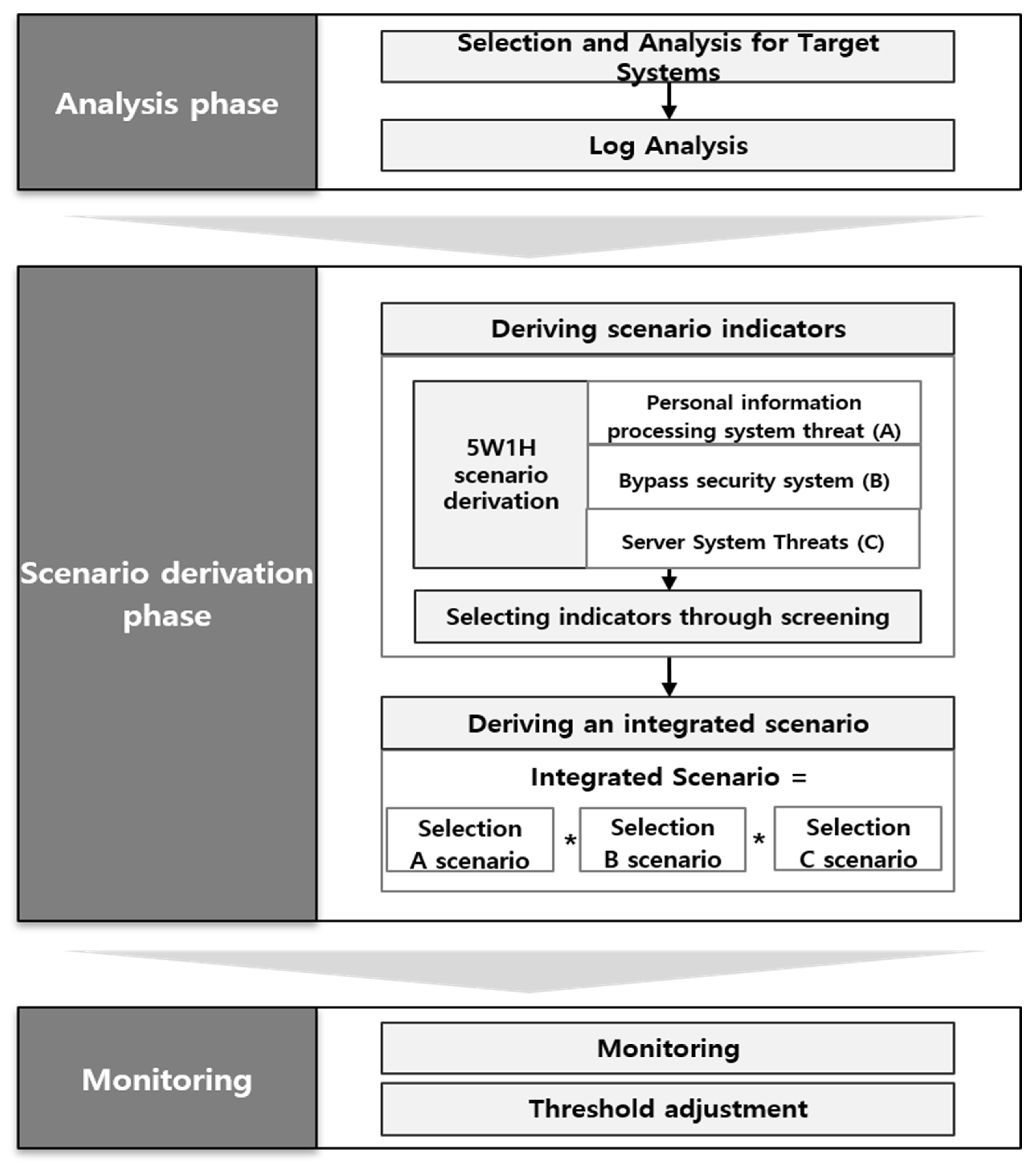

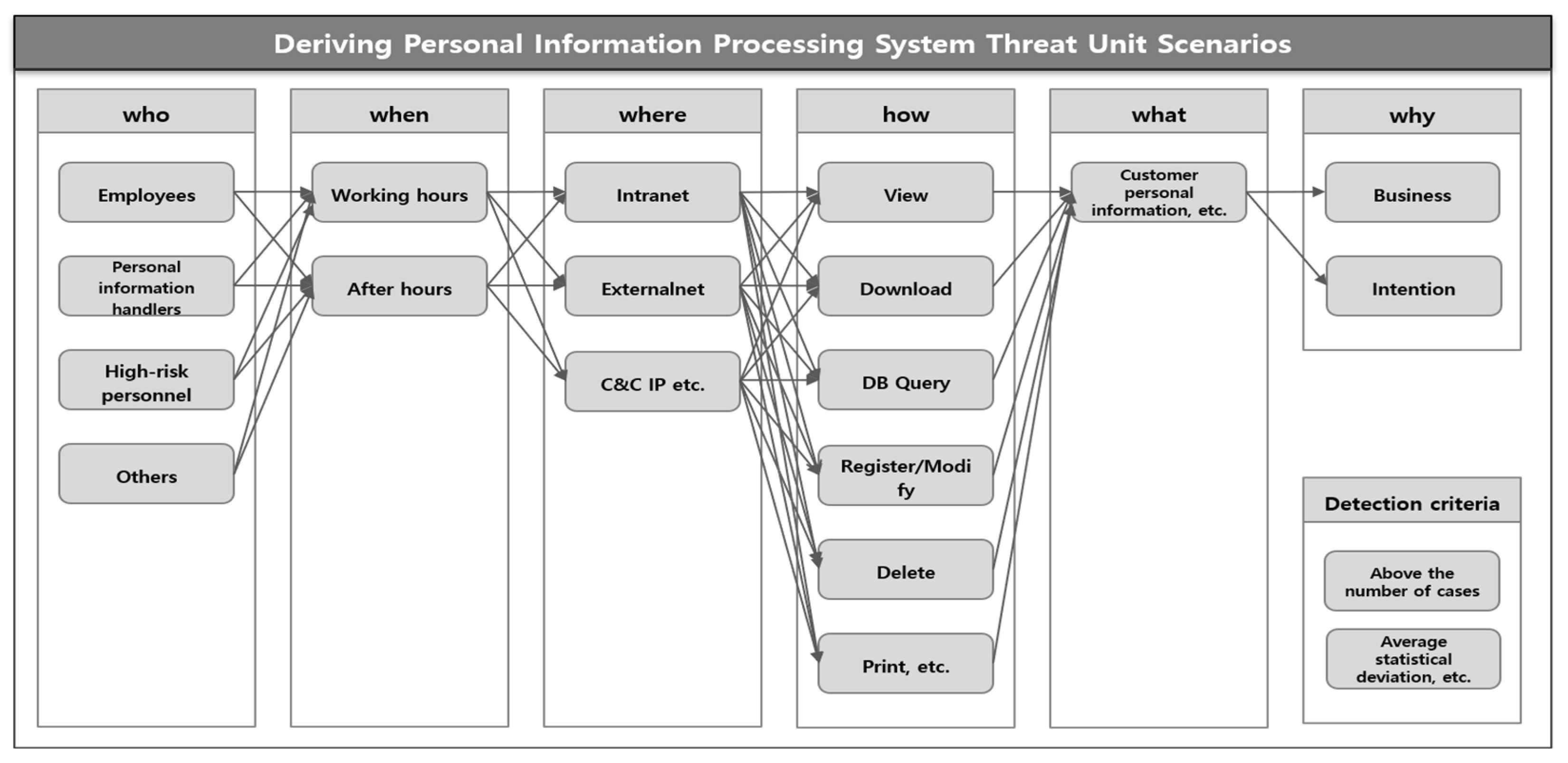
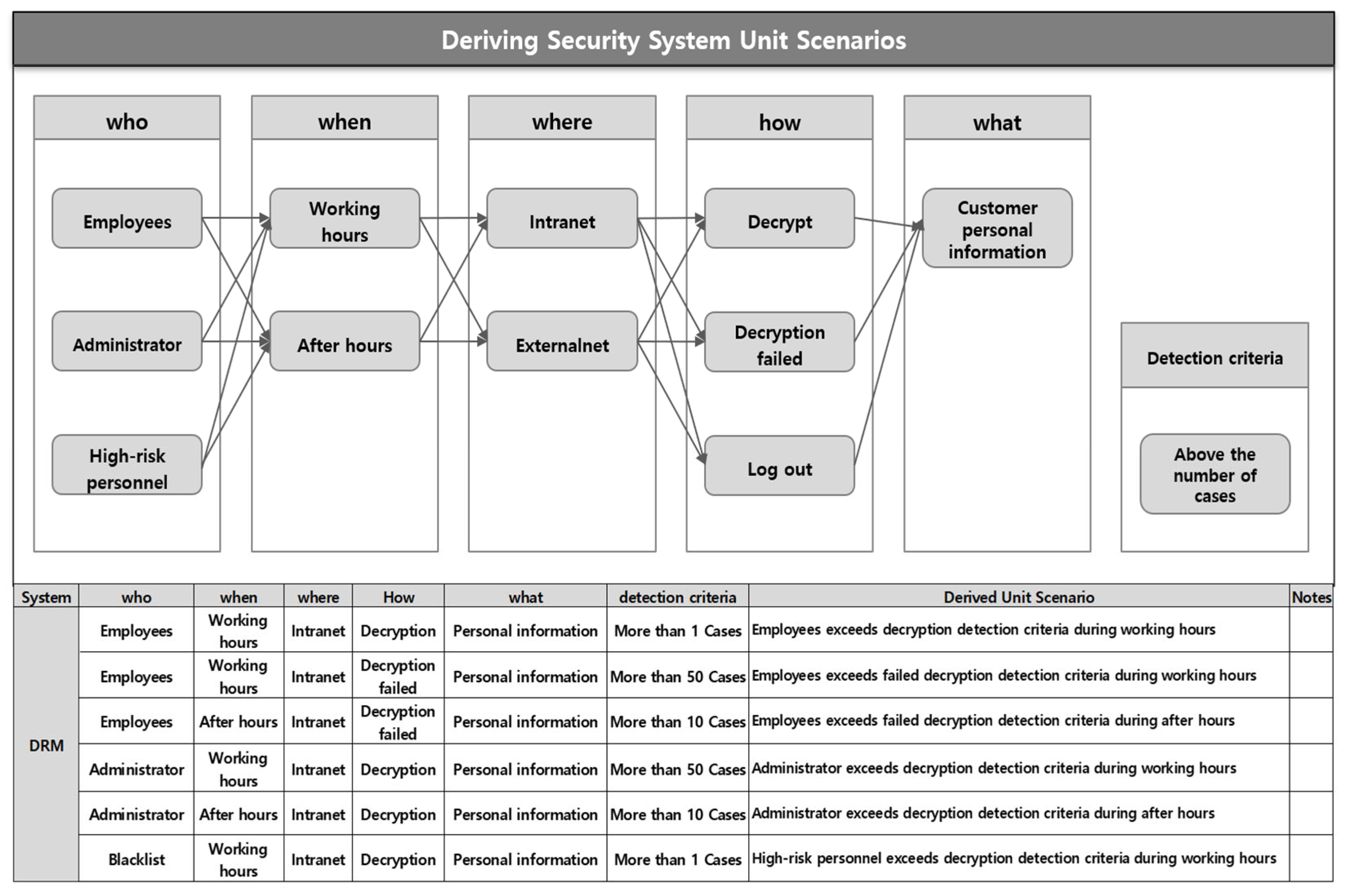
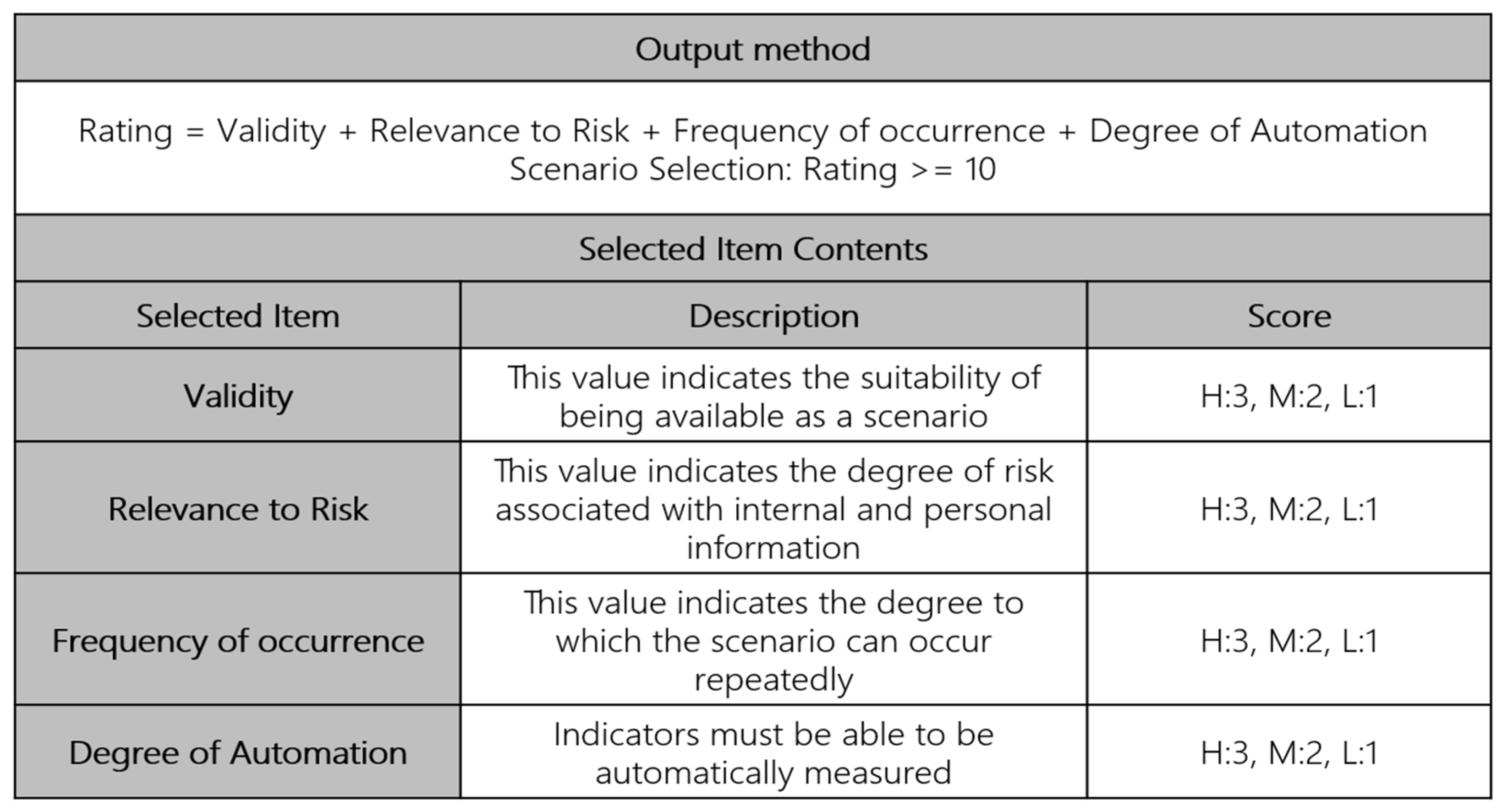
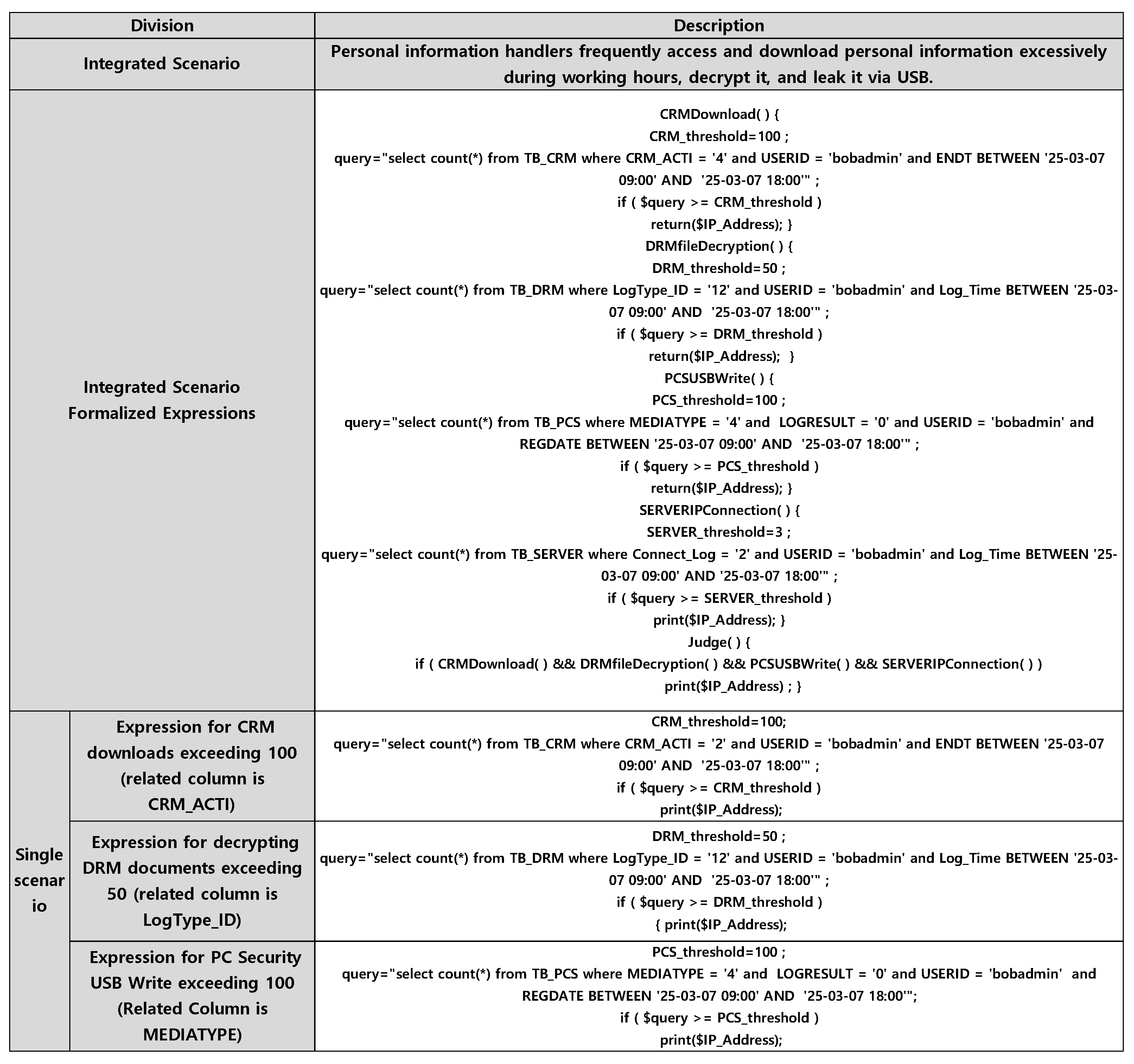





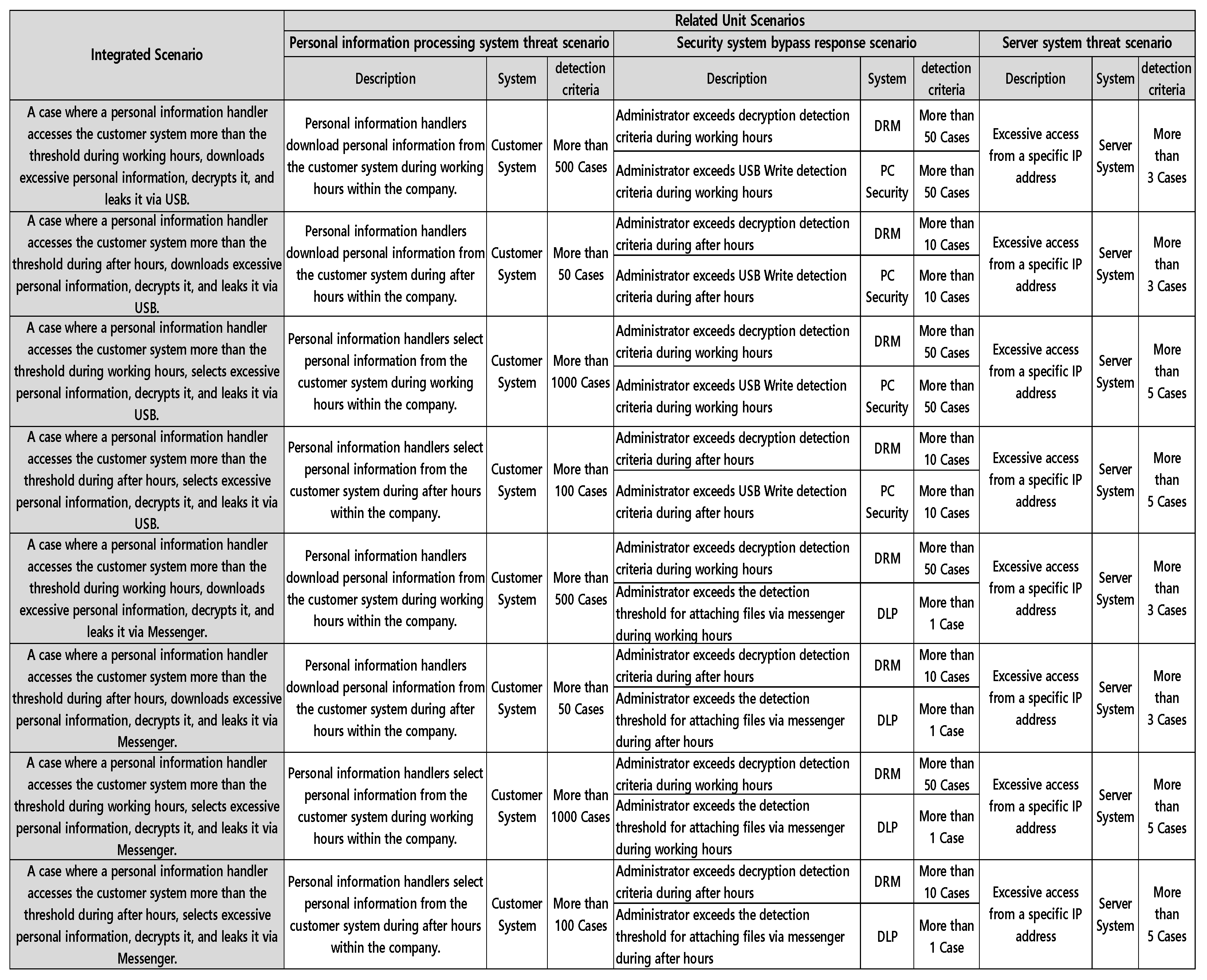

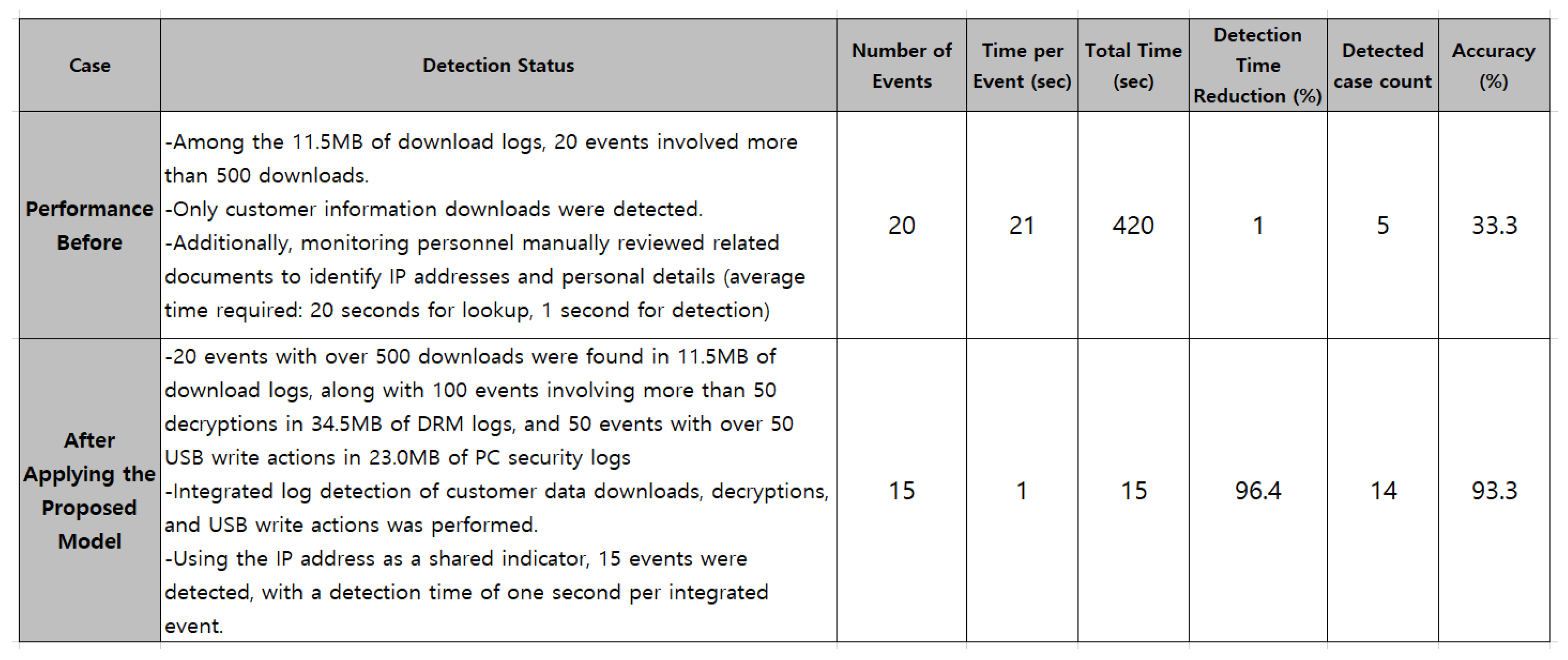

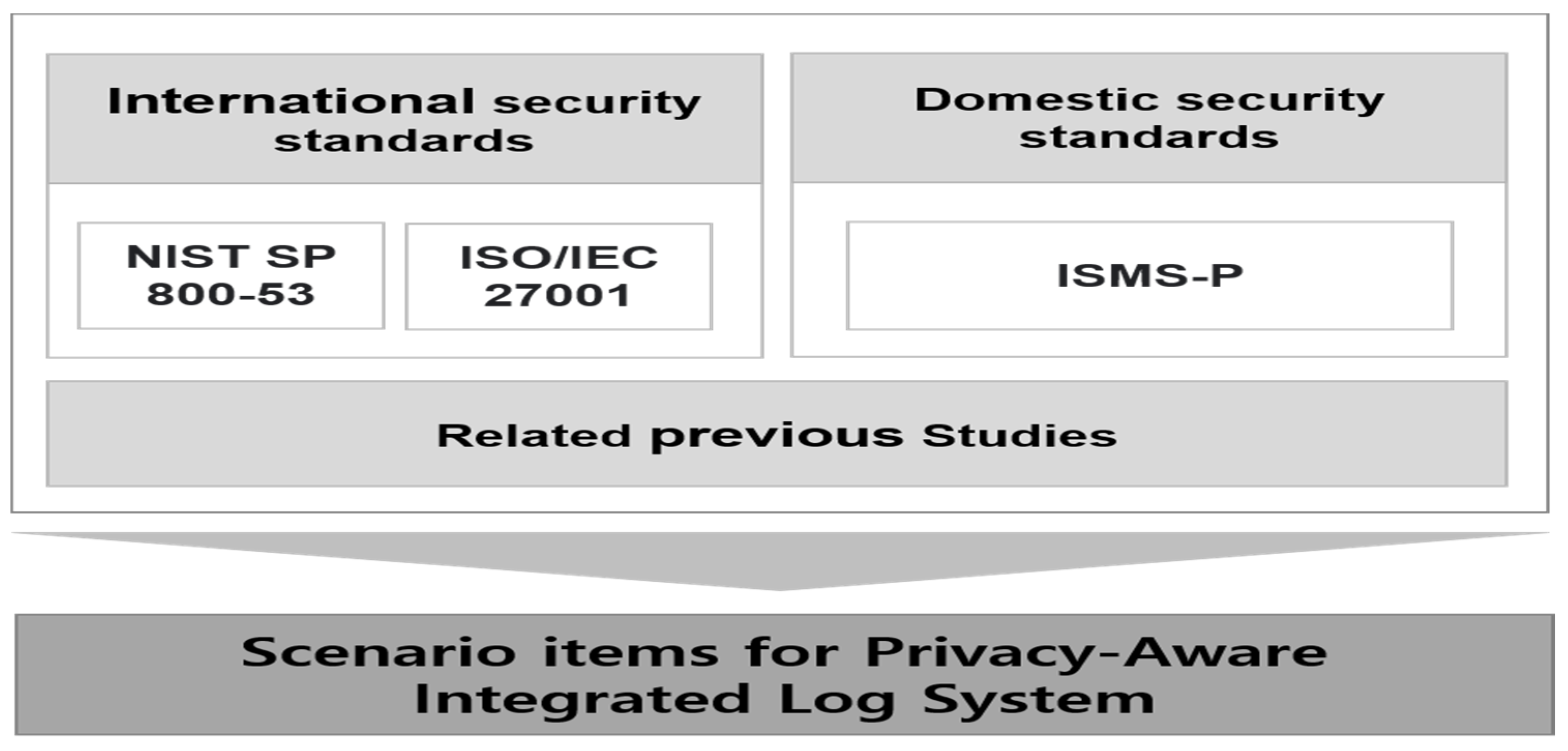
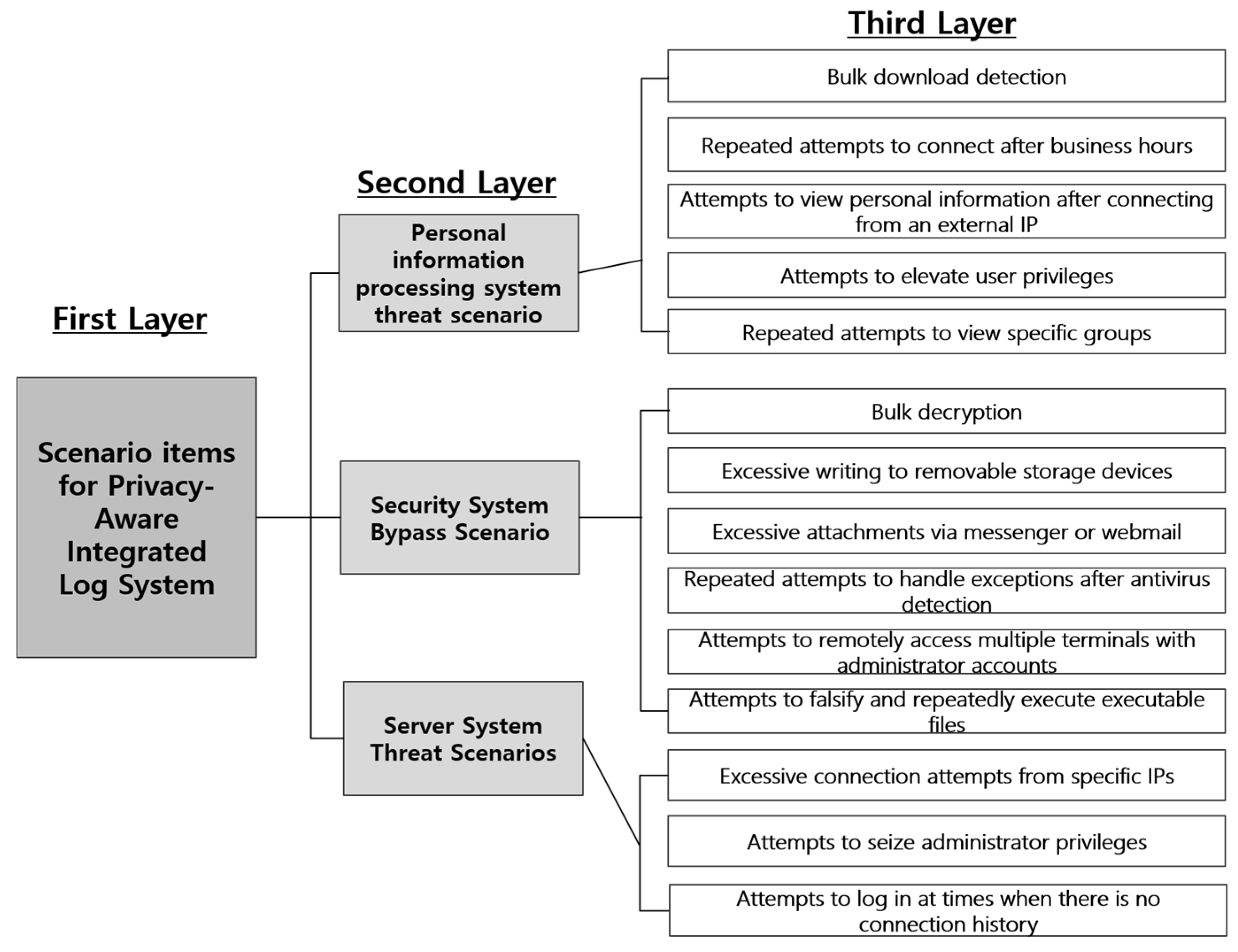
| Standard | Key Features | Perspective on Customer Data Protection | Relevance to This Study |
|---|---|---|---|
| ISO/IEC 27001 | International standard for Information Security Management Systems | Focused on risk management and information security policies | Provides a comprehensive framework for privacy protection |
| NIST SP 800-53 | U.S. federal framework for security and privacy controls | Detailed technical and managerial control elements | Includes control items useful for log collection, analysis, and behavior-based detection |
| ISMS-P | Korea’s integrated standard for information and personal data protection | Specifies protection requirements based on personal data flow and processing | Close association with mechanisms for responding to customer data breaches |
| GDPR | EU’s legal framework for personal data protection | Emphasizes consent-based processing, purpose limitation, data minimization, and user rights | Including justification for collecting logs related to employee behavior monitoring |
| Zero Trust Model | Security architecture based on “never trust, always verify” principle | Continuous authentication and authorization for users, devices, and applications | Applies security strategies such as least privilege and continuous monitoring to customer data access |
| Integrated Scenario | Associated Unit Scenarios | ||||||||
|---|---|---|---|---|---|---|---|---|---|
| Personal Information Processing System Threat Scenarios | Security System Bypass Response Scenario | Server System Threat Scenarios | |||||||
| Description | System | Detection criteria | Description | System | Detection criteria | Description | System | Detection criteria | |
| Personal data is accessed and downloaded in large volumes, decrypted, and exfiltrated through USB | Personal Data Download Count | CRM | 1 day/100 cases | Number of documents decrypted | DRM | 1 day/50 cases | Number of excessive connections | Linux | 1 day/3 cases |
| USB write count | PC Security | 1 day/100 cases | |||||||
| Integrated Scenario = Personal information processing system threat scenario ∧ Security system bypass response scenario ∧ Server system threat scenario | |||||||||
| Target System | Important Log Collection Information | Linked Form |
|---|---|---|
| DRM | Document Decryption History Screen Capture Event | DB |
| PC Security | USB write event History of print output | DB |
| POS Security | PE file change history Malware deletion event | syslog |
| Vaccine | Vaccine daemon off Patch Deploy history | DB |
| Network Isolation | Network Isolation Login History Inter-domain file transfer history | syslog |
| System access control | Telnet, ftp, etc., access history events Prohibition command execution events | DB |
| DB access control | DB access history event Executing commands such as selecting major tables | DB |
| DLP | External mail sending history External illegal messenger history | DB |
| Personal information processing system | Administrator access history information Administrator execution command history | DB |
| Server system | Excessive connection attempts Attempt to seize administrator privileges | rsyslog |
| Distinction | Security Policy | Whether Logs Are Created |
|---|---|---|
| DRM | Authorize creators to edit, decrypt, etc. Force encryption on save and exit Block copy and paste Set watermarking for output Control document viewing counts | O O O X O |
| PC Security | USB Read and Write Control Mobile Phone Tethering Control Website Access Monitoring Print Watermarking and History Management Messenger Conversation History Monitoring | O O X O X |
| System access control | Account lock settings Prohibited command settings Connection IP and MAC settings Access service control such as ssh, sftp | O O O O |
| DLP | Control illegal sites Allow Webhard for specific groups Monitor messenger conversation history Monitor external transmission mail Control remote control service | O O O O O |
| Second Layer | Third Layer | Final Relative Importance | Final Priorities | |||
|---|---|---|---|---|---|---|
| Items | Relative Importance of Second Layer | Scenario Items | Relative Importance of Third Layer | Priorities of Third Layer | ||
| Personal information processing system threat scenario | 0.479 | Bulk download detection | 0.5200 | 1 | 0.2491 | 1 |
| Repeated attempts to connect after business hours | 0.0770 | 3 | 0.0369 | 7 | ||
| Attempts to view personal information after connecting from an external IP | 0.0350 | 5 | 0.0168 | 12 | ||
| Attempts to elevate user privileges | 0.0540 | 4 | 0.0259 | 9 | ||
| Repeated attempts to view specific groups | 0.3140 | 2 | 0.1504 | 3 | ||
| Security System Bypass Scenario | 0.458 | Bulk decryption | 0.4240 | 1 | 0.1942 | 2 |
| Excessive writing to removable storage devices | 0.2990 | 2 | 0.1369 | 4 | ||
| Excessive attachments via messenger or webmail | 0.1080 | 3 | 0.0495 | 6 | ||
| Repeated attempts to handle exceptions after antivirus detection | 0.0380 | 6 | 0.0174 | 11 | ||
| Attempts to remotely access multiple terminals with administrator accounts | 0.0790 | 4 | 0.0362 | 8 | ||
| Attempts to falsify and repeatedly execute executable files | 0.0530 | 5 | 0.0243 | 10 | ||
| Physical level check | 0.063 | Excessive connection attempts from specific IPs | 0.7980 | 1 | 0.0503 | 5 |
| Attempts to seize administrator privileges | 0.1380 | 2 | 0.0087 | 13 | ||
| Attempts to log in at times when there is no connection history | 0.0640 | 3 | 0.0040 | 14 | ||
Disclaimer/Publisher’s Note: The statements, opinions and data contained in all publications are solely those of the individual author(s) and contributor(s) and not of MDPI and/or the editor(s). MDPI and/or the editor(s) disclaim responsibility for any injury to people or property resulting from any ideas, methods, instructions or products referred to in the content. |
© 2025 by the authors. Licensee MDPI, Basel, Switzerland. This article is an open access article distributed under the terms and conditions of the Creative Commons Attribution (CC BY) license (https://creativecommons.org/licenses/by/4.0/).
Share and Cite
Lim, D.-S.; Lee, S.-J. Privacy Protection in AI Transformation Environments: Focusing on Integrated Log System and AHP Scenario Prioritization. Sensors 2025, 25, 5181. https://doi.org/10.3390/s25165181
Lim D-S, Lee S-J. Privacy Protection in AI Transformation Environments: Focusing on Integrated Log System and AHP Scenario Prioritization. Sensors. 2025; 25(16):5181. https://doi.org/10.3390/s25165181
Chicago/Turabian StyleLim, Dong-Sung, and Sang-Joon Lee. 2025. "Privacy Protection in AI Transformation Environments: Focusing on Integrated Log System and AHP Scenario Prioritization" Sensors 25, no. 16: 5181. https://doi.org/10.3390/s25165181
APA StyleLim, D.-S., & Lee, S.-J. (2025). Privacy Protection in AI Transformation Environments: Focusing on Integrated Log System and AHP Scenario Prioritization. Sensors, 25(16), 5181. https://doi.org/10.3390/s25165181









